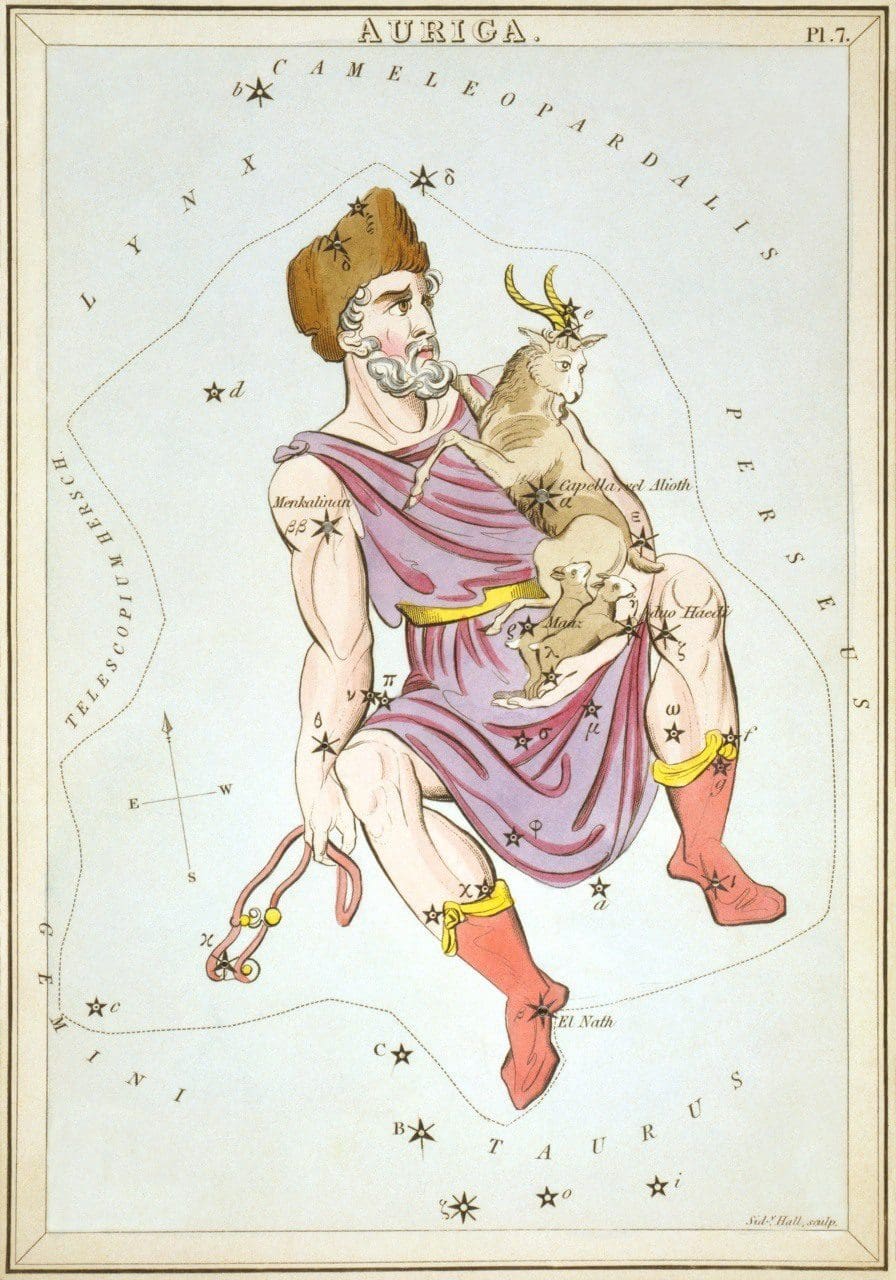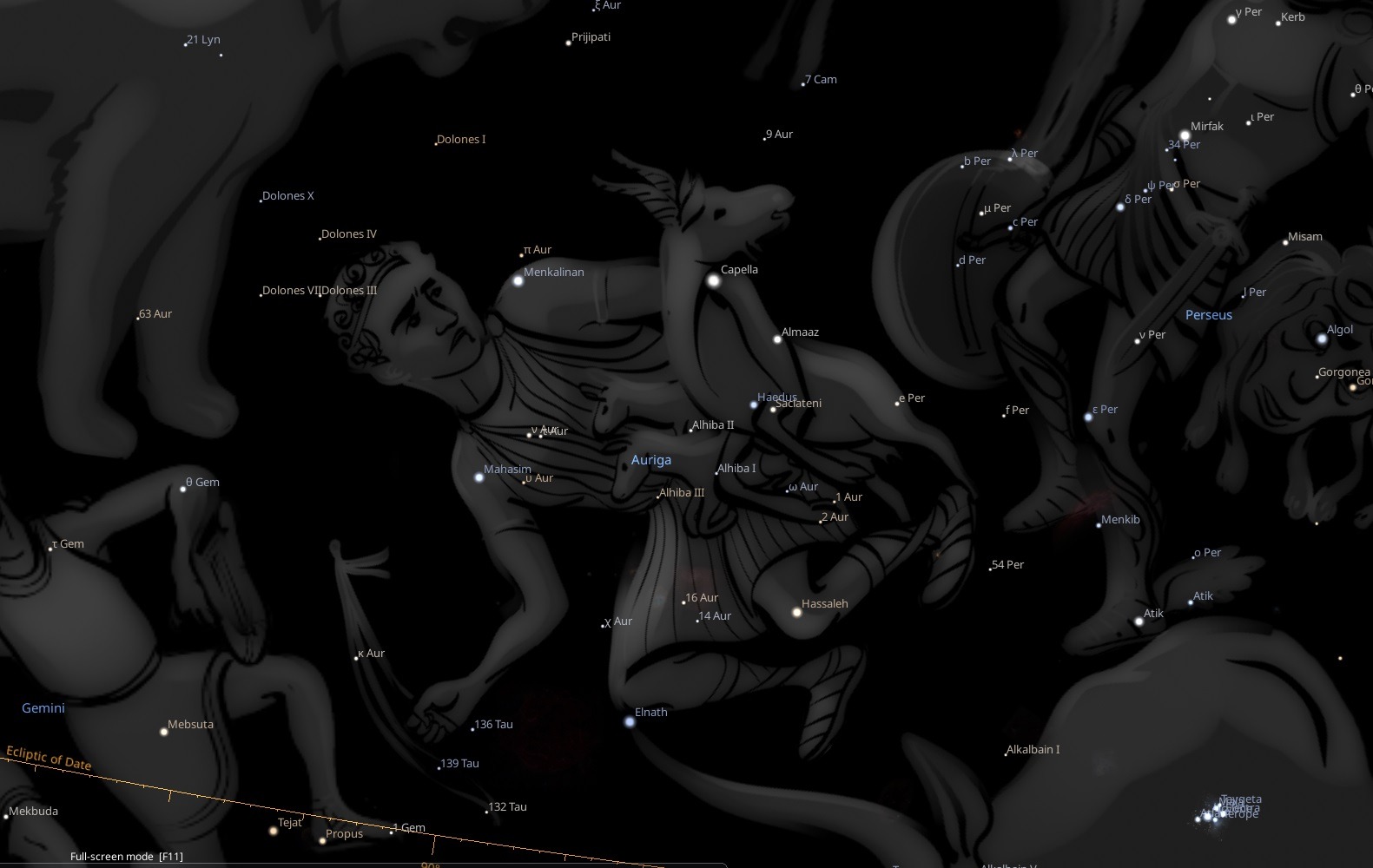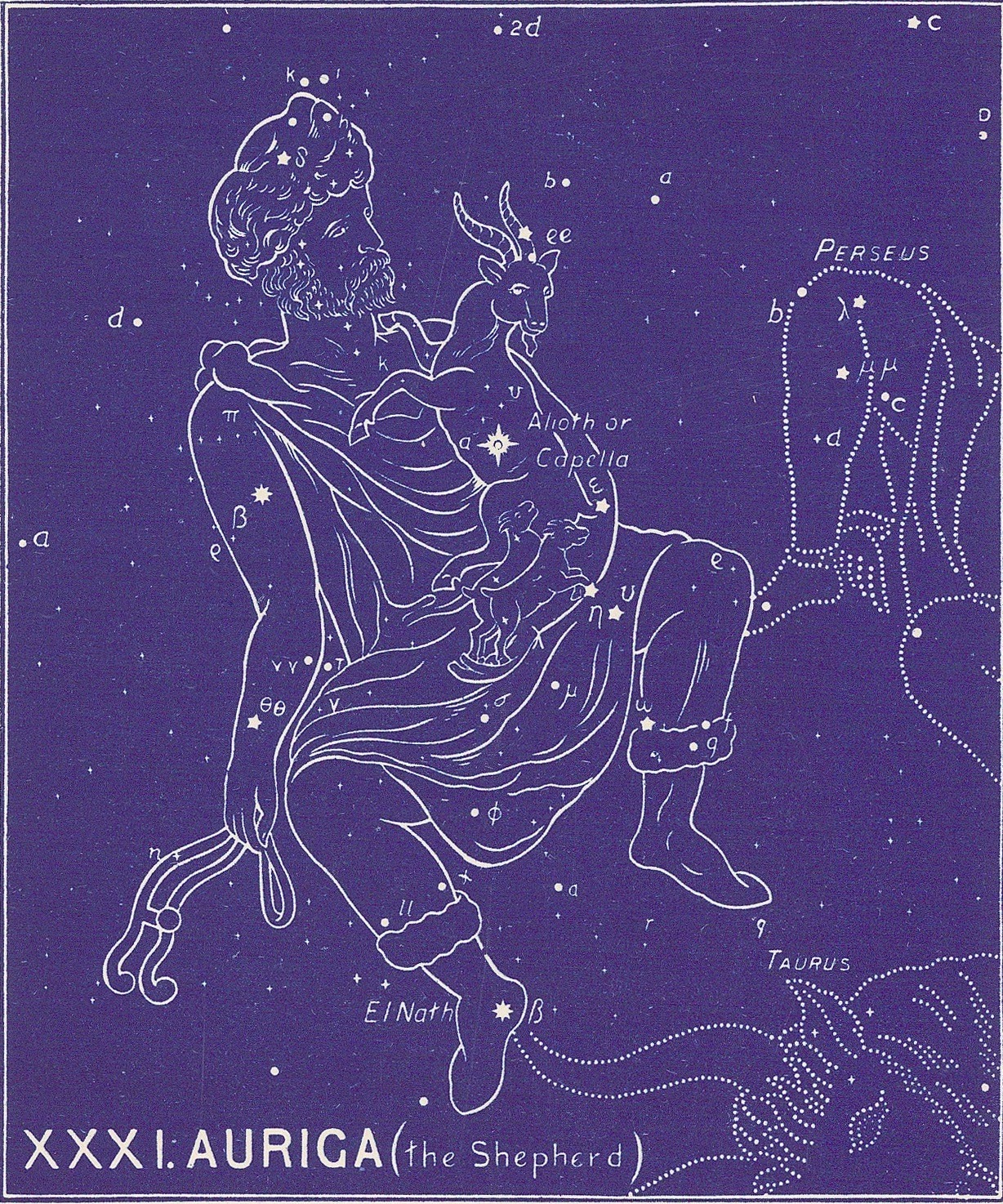FIXED STARS: Major Stars | 1000+ Stars | Constellations | About
Constellation Auriga the Charioteer is a northern constellation bordering Taurus, Gemini, Lynx, Camelpardalis, Perseus and the obsolete constellation Telescopium Herschelii.Auriga is one of the 48 constellations listed by Ptolemy in the 2nd century and remains one of the 88 modern constellations. It spans 40 degrees of the zodiac in the Signs of Gemini and Cancer.
Abbreviation: Aur
Genitive: Aurigae
Auriga Constellation Stars
| 2000 | 2050 | Star | Name | Sp. Class | Mag. | Orb |
|---|---|---|---|---|---|---|
| 16♊39 | 17♊21 | ι Aur | Hassaleh | K3 | 2.69 | 2°00′ |
| 18♊38 | 19♊20 | ζ Aur | Saclateni | K4 | 3.69 | 1°40′ |
| 18♊51 | 19♊33 | ε Aur | Almaaz | F0 | 3.03 | 2°00′ |
| 19♊27 | 20♊09 | η Aur | Haedus | B3 | 3.18 | 2°00′ |
| 20♊34 | 21♊17 | μ Aur | Al Hiba I | A4 | 4.82 | 1°00′ |
| 21♊51 | 22♊33 | λ Aur | Al Hiba II | G0 | 4.69 | 1°00′ |
| 21♊52 | 22♊34 | α Aur | Capella | G8 | 0.08 | 2°40′ |
| 22♊46 | 23♊29 | σ Aur | Al Hiba III | K4 | 5.02 | 1°00′ |
| 29♊55 | 00♋37 | β Aur | Menkalinan | A2 | 1.90 | 2°20′ |
| 29♊56 | 00♋38 | δ Aur | Prajapati | K0 | 3.72 | 1°30′ |
| 29♊57 | 00♋40 | θ Aur | Mahasim | A0 | 2.62 | 2°00′ |
| 04♋31 | 05♋13 | ψ1 Aur | Dolones I | K5 | 4.92 | 1°00′ |
| 07♋40 | 08♋23 | ψ2 Aur | Dolones II | K3 | 4.80 | 1°00′ |
| 07♋46 | 08♋28 | ψ3 Aur | Dolones III | B8 | 5.34 | 1°00′ |
| 08♋14 | 08♋56 | ψ4 Aur | Dolones IV | K5 | 5.04 | 1°00′ |
| 08♋41 | 09♋24 | ψ6 Aur | Dolones VI | K1 | 5.22 | 1°00′ |
| 09♋01 | 09♋43 | ψ5 Aur | Dolones V | G0 | 5.24 | 1°00′ |
| 09♋58 | 10♋40 | ψ7 Aur | Dolones VII | K3 | 4.99 | 1°00′ |
| 10♋36 | 11♋18 | ψ9 Aur | Dolones IX | B8 | 5.85 | 1°00′ |
| 10♋56 | 11♋38 | ψ8 Aur | Dolones VIII | B9 | 6.46 | 1°00′ |
| 10♋56 | 11♋39 | ψ10 Aur | Dolones X | A2 | 4.90 | 1°00′ |
| 14♋24 | 15♋06 | 63 Aur | K4 | 4.91 | 1°00′ | |
| 15♋27 | 16♋09 | 64 Aur | A5 | 5.87 | 1°00′ | |
| 16♋41 | 17♋23 | 66 Aur | K0 | 5.23 | 1°00′ | |
| 16♋52 | 17♋34 | 65 Aur | K0 | 5.12 | 1°00′ |
Auriga Astrology
Manilius
The Charioteer lifts his team from ocean and wrests his wheels up from the downward slope of the horizon where icy Boreas lashes us with his bitter blasts. He will impart his own enthusiasms and the skills, still retained in heaven, which as driver of a chariot he once took pleasure in on earth. The Charioteer will enable his son to stand in a light chariot and hold in check the four mouths curbed with foam-flecked bits, guide their powerful strength, and keep close to the curve round which they wheel. Again, when the bolts have been drawn and the horses have escaped from the starting-pens, he will urge on the spirited steeds and, leaning forward, he will seem to precede them in their swift career; hardly touching the surface of the track with his light wheels, he will outstrip the winds with his coursers’ feet. Holding first place in the contest he will drive to the side in a balking course and, his obstruction delaying his rivals, deny them the whole breadth of the circus-track; or if he is placed mid-way in the press, he will now swing to a course on the outside, trusting in the open, now keep close to the pointed turning-post, and will leave the result in doubt to the very last moment. As a trick-rider too he will be able to settle himself now on one, now on a second horse, and plant his feet firmly upon them: flying from horse to horse he will perform tricks on the backs of animals in flight themselves; or mounted on a single horse he will now engage in exercise of arms, now whilst still riding pick up gifts scattered along the length of the circus. He will possess virtuosity in all that is connected with such pursuits.
Of this constellation, I think, Salmoneus may be held to have been born imitating heaven on earth, he imagined that by setting his team of four on a bridge of bronze and driving it across he had expressed the crash of the heavens and had brought to earth Jove’s very self; however, while counterfeiting thunderbolts he was struck by real ones and, falling after the fires he had flung himself, discovered in death that Jove existed. You may well believe that under this constellation was born Bellerophon, who flew amid the stars and laid a road on heaven: the sky was the field over which he sped, whilst land and sea lay far beneath his feet, and his path was unmarked by footprints. By examples such as these are you to mark the rising figure of the Charioteer. [1]

Auriga Constellation [Urania’s Mirror]
Robson
Legend. Auriga represents Erichthonius, son of Vulcan and King of Athens, who was the first to devise a chariot drawn by four horses, which he used in order to conceal his greatly deformed feet. The goat and kids depicted in the constellation figure commemorate the goat upon whose milk Jupiter was reared, together with her offspring.
Influence. According to Ptolemy the bright stars are like Mars and Mercury. The constellation is said to give self-confidence, interest in social and educational problems, and happiness, but danger of great vicissitudes. The native is fond of country life and may be a teacher or have the upbringing of young people. By the Kabalists Auriga is associated with the Hebrew letter Samech and the 15th Tarot Trump “The Devil”. [2]
Noonan
Now called Auriga (Aur) this is one of the most fortunate constellations in the sky, but may still portend earthquakes if situated unfortunately as regard a solar eclipse. Ptolemy lists its stars as of the nature of Mars and Mercury. This constellation culminating in a chart presages honors, especially in the field of military and political endeavors. A modern astrologer might add sports whenever ancients mentioned military honors. [3]
Allen
Auriga, the Charioteer or Wagoner, in early days the Wainman.
It is a large constellation stretching northward across the Milky Way from its star γ, which also marks one of the Bull’s horns, to the feet of Camelopardalis, about 30° in extent north and south and 40° east and west; and is shown as a young man with whip in the right hand, but without a chariot, the Goat being supported against the left shoulder and the Kids on the wrist. This, with some variations, has been the drawing from the earliest days, when, as now, it was important, chiefly from the beauty of Capella and its attendant stars so prominent in the northwest in the spring twilight, and in the northeast in early autumn.
Ideler thinks that the original figure was made up of the five stars α, β, ε, ζ, and η; the Driver, represented by α, standing on an antique sloping Chariot marked by β; the other stars showing the reins. But later on the Chariot was abandoned and the reins transferred to their present position, the Goat being added by a misunderstanding, the word Ἄιξ, analogous to Ἀιγίς, simply meaning a Storm Wind that, apparently, in all former times the stars α, η, and ζ have portended at their heliacal rising, or by their disappearance in the mists. Still later to α as the Goat were added the near-by η and ζ as her Kids, the Ἔριφοι, — an addition that Hyginus [Astron. II.13] said was made by Cleostratos.
But the results of modern research now give us reason to think that the constellation originated on the Euphrates in much the same form as we have it, and that it certainly was a well-established sky figure there millenniums ago. A sculpture from Nimroud is an almost exact representation of Auriga with the Goat carried on the left arm; while in Graeco-Babylonian times the constellation Rukubi, the Chariot, lay here nearly coincident with our Charioteer, perhaps running over into Taurus.
Ἑνίοχος, the Rein-holder, was transcribed Heniochus by Latin authors, and personified by Germanicus and others as Erechtheus, or more properly Erichthonius, son of Vulcan and Minerva, who, having inherited his father’s lameness, found necessary some means of easy locomotion. This was secured by his invention of the four-horse chariot which not only well became his regal position as the 4th of the early kings of Athens, but secured for him a place in the sky.
Argelander counts 70 naked-eye stars here, and Heis 144. [4]
Bullinger
We have had the picture of a mighty Bull rushing forth; then the fiery river of the Judge; and now we see a Great Shepherd. He is seated upon “the milky way,” holding up on his left shoulder a she goat. She clings to his neck, and is looking down affrighted at the terrible on-rushing Bull. In his left hand he supports two little kids, apparently just born, and bleating, and trembling with fear.
AURIGA is from a Hebrew root which means a shepherd. It is a beautiful constellation of 66 stars; one of the 1st magnitude, two of the 2nd, nine of the 4th, etc. The brightest star, α (in the body of the goat), points her out as the prominent feature of the constellation, for its name Alioth (Hebrew) means a she goat. It is known by the modern Latin name Capella, which has the same meaning.
The next star, β (in the shepherd’s right arm), is called Menkilinon, and means the band, or chain of the goats, and points out the truth that they are never more to be lost again, but to be bound, with the bands of love, to the Shepherd for evermore. The name of another star is Maaz, which means a flock of goats. [5]
References
- Astronomica, Manilius, 1st century AD, p.305-309.
- Fixed Stars and Constellations in Astrology, Vivian E. Robson, 1923, p.31-32.
- Fixed Stars and Judicial Astrology, George Noonan, 1990, p.21.
- Star Names: Their Lore and Meaning, Richard H. Allen, 1889, p.83-92.
- The Witness of the Stars, E. W. Bullinger, 1893, AURIGA (the Shepherd).

